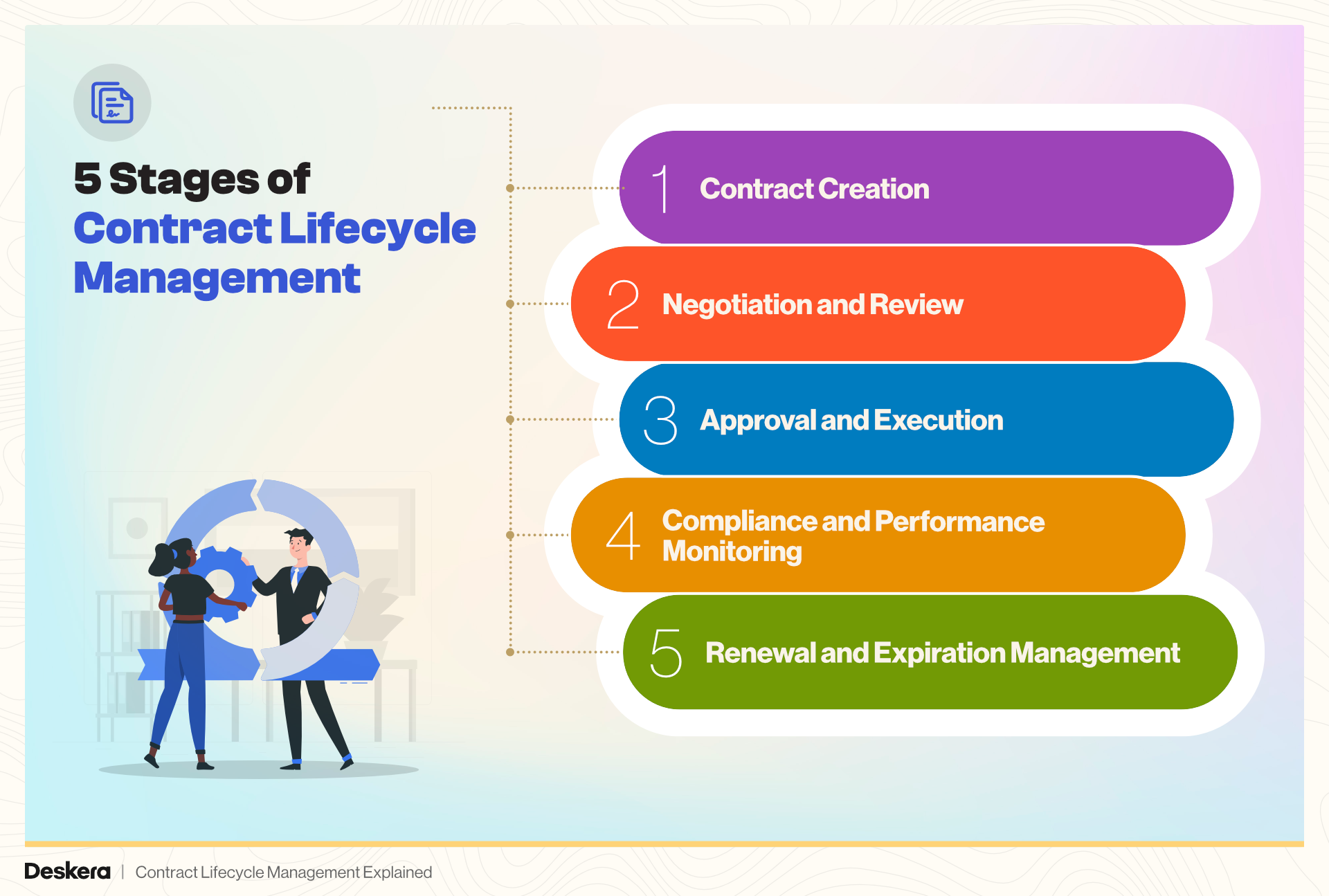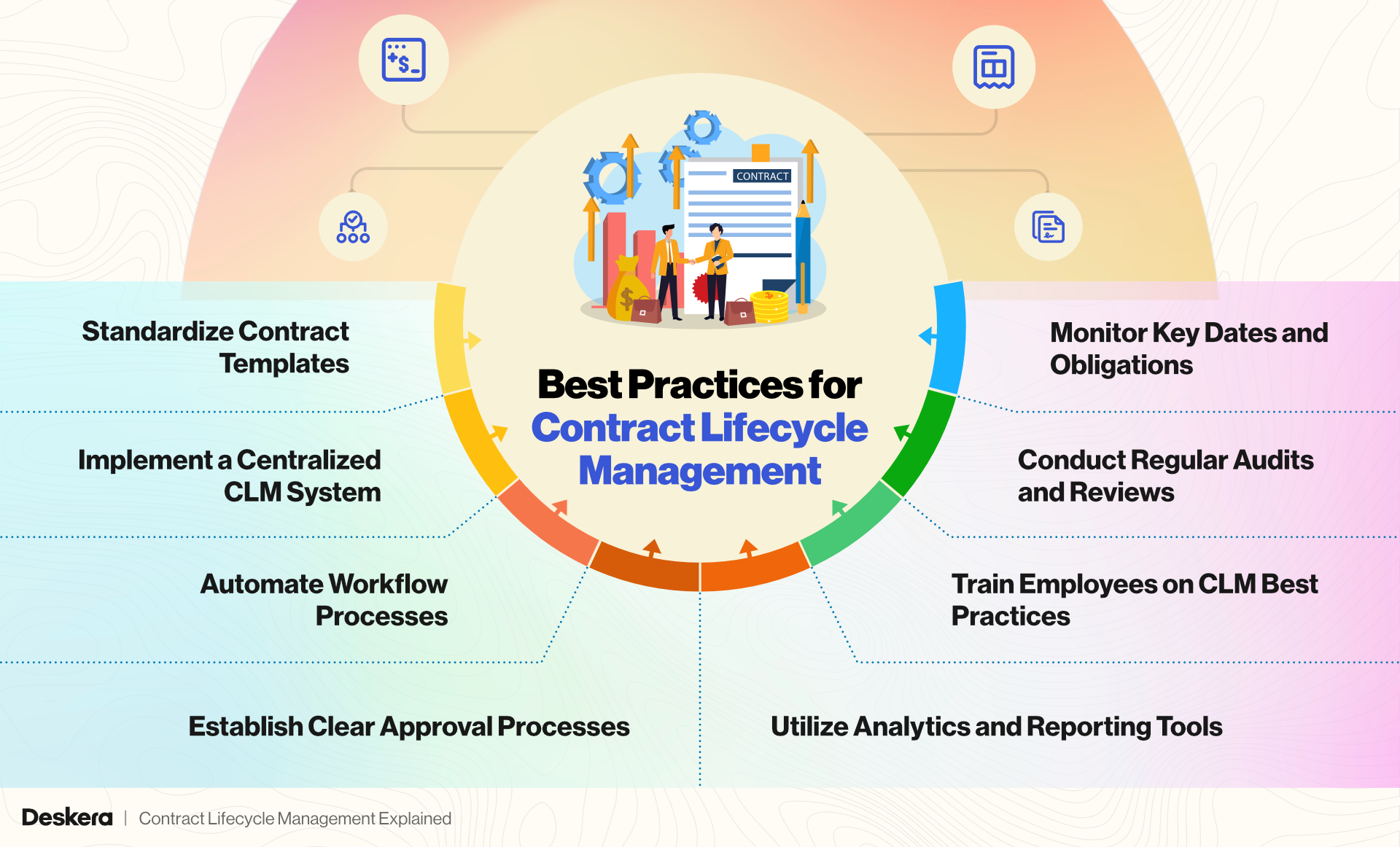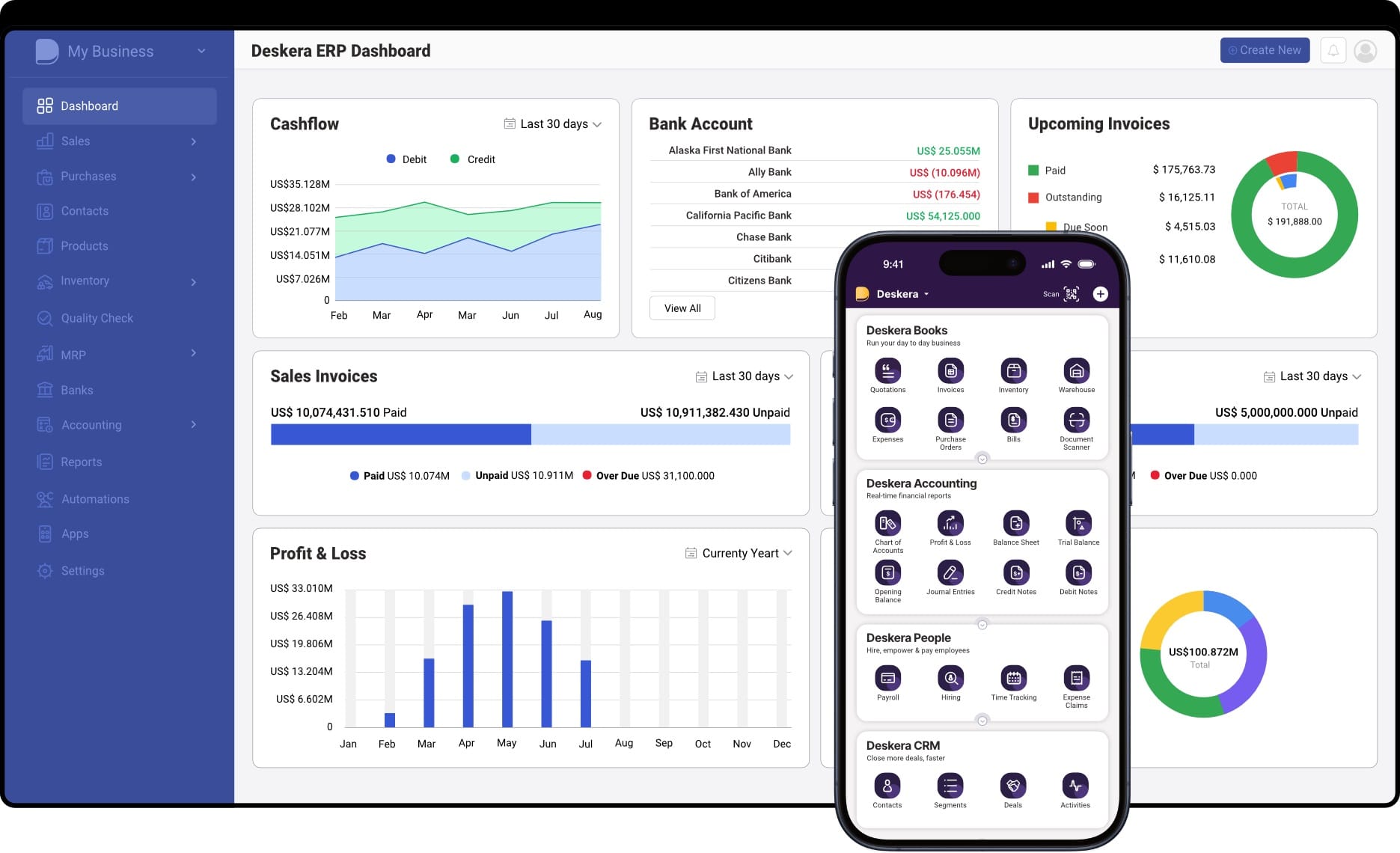The Contract Lifecycle Management (CLM) solution market was valued at $1.33 billion in 2022 and is expected to grow to $3.47 billion by 2030, with a compound annual growth rate (CAGR) of 13.0%.
This rapid growth reflects the increasing recognition among businesses of the need for efficient contract management to reduce risks, improve compliance, and drive operational efficiency. With contracts forming the backbone of business transactions, the demand for streamlined contract processes is higher than ever.
At its core, Contract Lifecycle Management (CLM) involves managing contracts from creation through execution, performance monitoring, and renewal or expiration. Without the right tools, this process can be complex, prone to delays, and vulnerable to errors.
CLM solutions are designed to automate and centralize these tasks, ensuring that businesses can handle their contractual obligations with minimal friction and maximum transparency. From reducing manual paperwork to automating compliance checks, CLM plays a crucial role in modern business strategies.
For businesses seeking to integrate CLM into broader enterprise resource planning (ERP) systems, Deskera offers a comprehensive solution. With its robust ERP and Material Requirements Planning (MRP) features, Deskera enables seamless contract management alongside inventory, production, and financial operations.
Deskera’s tools not only streamline contract workflows but also provide real-time insights and automation that help businesses maintain control over their contracts, procurement, and inventory—ultimately contributing to improved decision-making and business growth.
What is Contract Lifecycle Management (CLM)?
Contract Lifecycle Management (CLM) is the systematic process of managing a contract from its initial creation through to its execution, compliance, and eventual renewal or expiration. It encompasses every step of the contract process, ensuring that agreements are efficiently handled, risks are minimized, and compliance with legal and regulatory obligations is maintained.
CLM involves several stages, including the drafting and negotiation of contract terms, approval workflows, digital execution, performance monitoring, and automated renewals or terminations. This lifecycle approach helps businesses streamline the handling of contracts, improving efficiency and reducing the risk of errors, such as missed deadlines or non-compliance with legal obligations.
By adopting CLM solutions, companies can automate key contract management processes, provide real-time visibility into contract statuses, and ensure that all stakeholders are informed and aligned. This not only improves operational efficiency but also minimizes legal risks and enhances strategic decision-making.
5 Stages of Contract Lifecycle Management
The 5 Stages of Contract Lifecycle Management (CLM) are essential steps that help businesses effectively manage contracts from creation to completion. Each stage ensures that contracts are handled systematically, reducing risks, improving compliance, and enhancing efficiency.
Here's a breakdown of the key stages:

1. Contract Creation
This is the first step in the life cycle, where the contract is drafted based on pre-approved templates or customized clauses. During this stage, parties define the terms, conditions, deliverables, and other critical elements. Using CLM tools, businesses can automate the contract drafting process with standardized templates, reducing the likelihood of errors and speeding up the creation process.
2. Negotiation and Review
Once the contract is created, it moves into the negotiation phase. Parties review and redline the document, suggesting revisions to terms and conditions. This back-and-forth process is crucial to ensure that both parties' needs and expectations are met. CLM systems offer real-time collaboration tools and version tracking, which help streamline negotiations and reduce confusion between parties.
3. Approval and Execution
After negotiations, the contract requires formal approval before execution. This stage often involves internal stakeholders who must review and approve the contract. CLM solutions typically include automated workflows for routing contracts to the right individuals for approval, minimizing delays. Once approved, the contract is signed, often digitally, to expedite the process and maintain a secure audit trail.
4. Compliance and Performance Monitoring
Once the contract is executed, the focus shifts to monitoring compliance and performance. This involves tracking key obligations, deadlines, and deliverables to ensure that both parties meet their contractual responsibilities. CLM software can send automated reminders for critical dates, track performance metrics, and flag potential risks or breaches of contract.
5. Renewal and Expiration Management
As the contract nears its end, it enters the renewal or expiration stage. CLM systems automatically notify stakeholders when contracts are approaching renewal deadlines, helping businesses renegotiate terms or terminate contracts in a timely manner. Effective renewal management prevents contracts from lapsing unnoticed and ensures that businesses maximize the value of their agreements.
Each of these stages is crucial to managing contracts effectively, and leveraging a CLM solution helps streamline and automate these processes, ensuring that contracts are executed, monitored, and renewed with minimal risk and maximum efficiency.
Benefits of Contract Lifecycle Management
Contract Lifecycle Management (CLM) offers a range of benefits that can transform the way organizations handle contracts. By streamlining processes, improving compliance, and increasing visibility, CLM helps businesses operate more efficiently and reduce risks.
Here are some key benefits:
1. Improved Efficiency and Automation
One of the most significant benefits of CLM is the automation of manual processes, such as contract creation, approvals, and renewals. Automated workflows eliminate time-consuming tasks, reducing the chance of errors and speeding up the entire contract lifecycle. This efficiency enables businesses to close deals faster and focus on more strategic tasks.
2. Enhanced Compliance and Risk Management
CLM systems help ensure that contracts comply with legal and regulatory requirements. By automating compliance checks and maintaining audit trails, organizations can minimize the risk of penalties and legal disputes. Additionally, CLM tools help monitor contract terms, obligations, and deadlines, reducing the likelihood of missed commitments that could lead to breaches of contract.
3. Centralized Contract Repository
CLM solutions provide a centralized location for storing and managing contracts, making it easy to access, track, and analyze agreements. This centralized repository ensures that all stakeholders have real-time visibility into contract statuses, key terms, and critical dates, improving collaboration and reducing the risk of contracts being lost or overlooked.
4. Better Contract Visibility and Control
With a CLM system, businesses can gain full visibility into the status and performance of contracts throughout their lifecycle. This transparency allows organizations to proactively monitor contract performance, identify potential risks, and take action before issues arise. It also enables more informed decision-making based on up-to-date contract data.
5. Cost Savings and Revenue Optimization
By reducing inefficiencies and minimizing risks, CLM systems can significantly reduce costs associated with contract management. Automating renewals and renegotiations ensures that businesses do not miss opportunities for revenue optimization or savings. Furthermore, identifying underperforming contracts allows organizations to renegotiate or terminate unprofitable agreements.
6. Improved Collaboration Across Departments
CLM platforms facilitate better collaboration between legal, procurement, sales, and other departments by providing a unified system for managing contracts. Automated approval workflows and real-time access to contract data enable stakeholders to work together more effectively, speeding up negotiations and ensuring that all parties are aligned.
Incorporating a CLM solution helps businesses not only manage contracts more effectively but also unlock opportunities for increased efficiency, compliance, and financial performance. By centralizing contract management and automating key processes, organizations can reduce risks and drive long-term success.
Challenges of Contract Lifecycle Management
Contract Lifecycle Management (CLM), while essential for managing business agreements efficiently, comes with its own set of challenges. These obstacles can slow down processes, create compliance risks, and impact the overall effectiveness of contract management.
Here are some key challenges faced in CLM:
1. Lack of Standardization
Inconsistent contract templates and clauses are common in organizations that don’t use a standardized approach. This can lead to confusion, errors, and inefficiencies, as legal teams and other stakeholders may not be aligned on what terms to use, creating variations in contract language and increasing legal risks.
2. Manual Processes and Human Error
Many organizations still rely on manual processes to manage contracts, leading to inefficiencies and a higher likelihood of errors. Data entry mistakes, missed deadlines, and incorrect approvals can disrupt the contract lifecycle, delay operations, and increase the risk of non-compliance with contractual obligations or regulations.
3. Poor Visibility and Tracking
Without a centralized system for managing contracts, it’s difficult for businesses to track contract statuses, deadlines, and obligations effectively. This lack of visibility can result in missed renewals, unnoticed contract expirations, or failure to meet critical milestones, all of which can negatively impact business outcomes.
4. Compliance and Regulatory Risks
Keeping up with evolving legal and regulatory requirements can be challenging for businesses, especially when contracts span multiple jurisdictions. Non-compliance with regulations can lead to financial penalties, legal disputes, and reputational damage. Ensuring that contracts are always up-to-date and compliant with laws is a constant challenge, particularly in heavily regulated industries.
5. Inefficient Approval Workflows
Contracts often require approval from multiple stakeholders, which can slow down the process if workflows are inefficient. Without automated approval mechanisms, contracts can get stuck in bottlenecks, leading to delays in finalizing agreements. This lack of speed can hinder business relationships and impact time-sensitive deals.
6. Fragmented Systems
Organizations that manage contracts across different departments or tools often face integration challenges. When contracts are stored in various systems or formats, it becomes difficult to maintain consistency, ensure compliance, and extract valuable insights. A lack of integration can lead to duplications, loss of important data, and inefficient management.
Addressing these challenges through robust CLM tools and processes is critical for improving efficiency, ensuring compliance, and optimizing contract performance. By automating manual processes and centralizing contract management, businesses can reduce risks, gain better visibility, and streamline their contract lifecycle operations.
Best Practices for Contract Lifecycle Management
Implementing best practices for Contract Lifecycle Management (CLM) is essential for maximizing efficiency, ensuring compliance, and minimizing risks associated with managing contracts.
Here are some key best practices to consider:

1. Standardize Contract Templates
Develop and use standardized templates for different types of contracts to ensure consistency and reduce errors. Standardization helps streamline the contract creation process, making it easier for legal and procurement teams to draft agreements that comply with company policies and legal requirements.
2. Implement a Centralized CLM System
Utilize a centralized CLM solution to manage all contracts in one location. This system should provide a comprehensive repository for storing, tracking, and analyzing contracts. A centralized approach enhances visibility, improves collaboration, and ensures that all stakeholders have access to the most up-to-date contract information.
3. Automate Workflow Processes
Leverage automation to manage contract workflows, from creation and negotiation to approval and renewal. Automated workflows can significantly reduce processing times, minimize human error, and ensure that contracts are routed to the right stakeholders for review and approval in a timely manner.
4. Establish Clear Approval Processes
Define and communicate clear approval processes for contracts to avoid bottlenecks and delays. Ensure that all stakeholders understand their roles and responsibilities in the approval workflow. This clarity helps streamline contract approvals and fosters accountability among team members.
5. Monitor Key Dates and Obligations
Utilize CLM tools to track critical dates, such as renewal deadlines, performance milestones, and compliance requirements. Automated reminders and alerts can help ensure that stakeholders are notified in advance of important deadlines, reducing the risk of missed obligations or contract expirations.
6. Conduct Regular Audits and Reviews
Implement regular audits of contract management processes to identify areas for improvement. Periodic reviews can help assess compliance with contractual obligations, identify risks, and uncover opportunities for renegotiation or optimization. This practice ensures that contracts remain aligned with business goals and regulatory requirements.
7. Train Employees on CLM Best Practices
Invest in training for employees involved in contract management to ensure they are familiar with CLM best practices and the tools being used. Training can improve compliance, enhance collaboration, and empower team members to make informed decisions throughout the contract lifecycle.
8. Utilize Analytics and Reporting Tools
Leverage analytics and reporting capabilities within your CLM system to gain insights into contract performance and trends. Analyzing data can help organizations identify underperforming contracts, optimize pricing strategies, and improve overall contract management efficiency.
By following these best practices, organizations can create a robust CLM strategy that enhances operational efficiency, mitigates risks, and drives better business outcomes. Implementing effective contract management processes is essential for ensuring compliance and maximizing the value derived from contracts.
Tools and Processes for Contract Lifecycle Management
Tools and Processes for Contract Lifecycle Management (CLM) are essential for effectively managing contracts throughout their lifecycle. Utilizing the right tools and processes can enhance efficiency, improve compliance, and reduce risks.
Here’s an overview of key tools and processes involved in CLM:
1. CLM Software
CLM software automates the entire contract lifecycle, from creation to execution and beyond. By streamlining processes such as drafting, negotiation, and approvals, this software minimizes manual effort and reduces the risk of errors. Additionally, it helps manage contract deliverables and renewals efficiently, ensuring that contracts are kept up-to-date and obligations are met.
2. Centralized Repository
A centralized repository serves as a single location for storing all contracts, making it easier for organizations to track and manage them. This centralization enhances visibility and ensures that all contracts comply with regulations and internal policies. With a centralized system, stakeholders can access the latest contract versions and avoid confusion over document locations.
3. Reporting and Analytics
Access to on-demand reporting is crucial for contract management teams. Effective CLM tools provide robust reporting features that allow users to generate reports on different types of digital contracts. Tracking access history and version changes is equally important, as it provides insights into contract usage and ensures accountability within the contract management process.
4. Risk Management
Effective CLM software supports risk management by allowing organizations to configure alerts based on specified rules. These alerts help keep users informed of compliance and security issues, enabling proactive measures to mitigate risks associated with contracts. By identifying potential issues early, organizations can address them before they escalate.
5. Compliance Monitoring
Maintaining compliant contract practices is essential for organizations to avoid the financial consequences of non-compliance. CLM software assists in ensuring that all contracts adhere to relevant laws and regulations. By automating compliance checks and maintaining audit trails, organizations can mitigate risks and demonstrate their commitment to regulatory requirements.
6. Enhanced Visibility
One of the key advantages of CLM is the enhanced visibility it provides into the entire contract lifecycle. Organizations can easily track contract statuses, monitor performance, and identify areas for improvement. This visibility helps stakeholders stay informed and engaged throughout the lifecycle, ultimately leading to better contract management outcomes.
What is a Contract Management System?
A Contract Management System (CMS) is a specialized software application designed to streamline and automate the processes involved in managing contracts throughout their entire lifecycle.
This system facilitates the creation, execution, tracking, and analysis of contracts, helping organizations ensure compliance, mitigate risks, and enhance operational efficiency.
The Need for Contract Management Systems
The need for contract management systems (CMS) has grown significantly as organizations face increasingly complex regulatory environments, competitive markets, and the necessity for efficient operations. These systems provide essential tools and processes for managing contracts throughout their lifecycle, ensuring compliance, and maximizing value.
Here are several key reasons why businesses require robust contract management systems:
1. Enhanced Efficiency
Contract management systems streamline the entire contract lifecycle, from creation and negotiation to execution and renewal. By automating manual processes, such as approvals and notifications, organizations can reduce the time and resources spent on contract management. This increased efficiency allows teams to focus on strategic initiatives rather than getting bogged down by administrative tasks.
2. Improved Compliance and Risk Mitigation
With growing regulatory requirements and the potential for financial penalties, maintaining compliance is more critical than ever. CMS helps organizations implement standardized contract processes, ensuring that contracts adhere to legal and regulatory obligations. By providing tools for monitoring compliance and tracking obligations, these systems help mitigate risks associated with contract breaches and non-compliance.
3. Centralized Repository for Contracts
A contract management system acts as a centralized repository for all contracts, making it easier for stakeholders to access, manage, and analyze agreements. This centralization reduces the risk of lost or misplaced contracts and ensures that all team members are working with the most up-to-date information. Additionally, a centralized system facilitates better collaboration across departments, improving communication and contract oversight.
4. Data-Driven Insights and Reporting
Contract management systems provide robust analytics and reporting capabilities, allowing organizations to gain valuable insights into contract performance and trends.
By analyzing data on contract compliance, financial impacts, and vendor performance, businesses can make informed decisions, identify areas for improvement, and optimize contract negotiations.
5. Enhanced Visibility and Tracking
A CMS offers enhanced visibility into the status and performance of contracts throughout their lifecycle. Organizations can easily track key dates, such as renewals and milestones, ensuring that no critical obligations are missed. This visibility not only improves accountability but also enables proactive management of contracts, leading to better outcomes.
6. Scalability and Adaptability
As businesses grow and evolve, their contract management needs may change. Contract management systems are designed to scale with the organization, accommodating increasing volumes of contracts and more complex processes. This adaptability ensures that the system remains effective even as the business landscape shifts.
7. Cost Savings
By streamlining processes, reducing risks, and improving compliance, contract management systems can lead to significant cost savings for organizations. Efficient contract management can minimize delays in contract execution, reduce the likelihood of disputes, and optimize contract terms and pricing, ultimately contributing to better financial performance.
Choosing the Right CLM Software
Choosing the right Contract Lifecycle Management (CLM) software is a critical decision for organizations looking to optimize their contract management processes.
With numerous options available, it’s essential to evaluate various factors to ensure the selected software aligns with your business needs and objectives.
Here are key considerations to help guide your decision-making process:
1. Assess Your Business Requirements
Start by identifying your organization's specific contract management needs. Consider the types of contracts you manage, the volume of contracts processed, and the unique workflows within your organization.
Engaging stakeholders from different departments—such as legal, procurement, sales, and finance—will provide valuable insights into their requirements and expectations.
2. Evaluate Key Features and Functionality
When comparing CLM software options, pay close attention to the features and functionality offered. Essential features to look for include:
- Contract Creation and Editing: Easy-to-use templates and editing tools for drafting contracts.
- Automated Workflows: Tools to automate approvals, notifications, and reminders.
- Centralized Repository: A secure location for storing and accessing contracts.
- Reporting and Analytics: Robust reporting capabilities to analyze contract performance and compliance.
- Integration Capabilities: Compatibility with existing software systems, such as ERP, CRM, or document management tools.
3. Consider User Experience and Accessibility
The user experience is critical to the successful adoption of any software. Look for CLM solutions that offer intuitive interfaces and easy navigation.
Ensure that the software is accessible across devices, including mobile, to accommodate remote or on-the-go users. A positive user experience can significantly enhance productivity and reduce training time.
4. Scalability and Flexibility
Choose CLM software that can grow with your organization. As your contract volume and complexity increase, the software should be able to scale accordingly.
Look for flexibility in features and configurations to adapt to changing business needs, industry regulations, and compliance requirements.
5. Security and Compliance Features
Given the sensitive nature of contracts, security is a top priority. Assess the security measures offered by the CLM software, including data encryption, access controls, and user authentication protocols.
Additionally, ensure that the software supports compliance with relevant regulations and industry standards, such as GDPR, HIPAA, or ISO certifications.
6. Vendor Support and Training
Evaluate the level of support and training provided by the software vendor. Effective customer support is essential for resolving issues and ensuring smooth operation.
Check if the vendor offers training resources, such as webinars, documentation, and user guides, to facilitate user adoption and ongoing education.
7. Cost and Return on Investment (ROI)
Consider the total cost of ownership, including initial licensing fees, implementation costs, and ongoing maintenance or subscription fees.
Compare the costs with the potential ROI that the software can deliver through improved efficiency, reduced risks, and enhanced compliance. Investing in the right CLM software can lead to substantial long-term savings.
8. Read Reviews and Request Demos
Research user reviews and testimonials to gain insights into the experiences of other organizations with the CLM software. Additionally, request demos or trial versions to explore the software firsthand. This hands-on experience can help you assess whether the solution meets your expectations and fits your organizational culture.
By carefully evaluating these factors, organizations can make informed decisions when selecting CLM software that best suits their needs. Choosing the right solution not only enhances contract management processes but also contributes to better compliance, risk mitigation, and overall business success.
How Can Deskera Help With Contract Lifecycle Management?
Deskera offers comprehensive solutions that can significantly enhance your Contract Lifecycle Management (CLM) processes through its Deskera ERP platform.
Here’s how Deskera can help you effectively manage contracts throughout their lifecycle:

Integration with Other Business Functions
Deskera ERP integrates seamlessly with various business functions such as procurement, sales, finance, and project management. This integration ensures that all relevant departments can access contract information, enabling better alignment and coordination across the organization. For instance, sales teams can quickly retrieve contract terms to fulfill customer inquiries, while finance can track payment terms and conditions.
Mobile Accessibility
With Deskera ERP, users can access contract information on the go via mobile devices. This mobile accessibility ensures that stakeholders can review, approve, and manage contracts anytime and anywhere, promoting responsiveness and agility in contract management.
Audit Trails and Version Control
Deskera ERP maintains comprehensive audit trails for all contract activities, providing a clear record of changes, approvals, and access history. This feature is crucial for compliance purposes and helps organizations track who accessed or modified a contract, ensuring accountability.
Custom Alerts and Notifications
Users can configure custom alerts based on specific contract conditions or thresholds. For example, organizations can set alerts for significant contract milestones, such as renewals or renegotiations, enabling proactive management and timely actions.
Tracking and Alerts
With Deskera, you can track important contract milestones, such as expiration dates and renewal deadlines. Automated alerts and notifications help stakeholders stay informed about key contract events, ensuring proactive management.
Reporting and Analytics
Deskera ERP provides robust reporting tools that allow organizations to analyze contract performance and compliance. Users can generate insightful reports to identify trends, assess risks, and improve overall contract management strategies.
Compliance and Risk Management
Deskera helps organizations maintain compliance with relevant regulations and internal policies. The system provides tools for tracking compliance and managing risks associated with contracts, helping to protect the organization from potential legal issues.
Integration with Other Modules
As part of the Deskera ERP suite, the CLM capabilities can integrate seamlessly with other business functions, such as finance, procurement, and sales. This integration ensures that contract management aligns with overall business processes, providing a holistic view of organizational performance.
Financial Management Integration
Deskera ERP integrates contract management with financial management, allowing organizations to track financial obligations, payment schedules, and revenue recognition tied to contracts. This integration provides a complete view of financial commitments related to contracts and enhances financial forecasting.
User-Friendly Interface and Training Resources
Deskera's intuitive interface simplifies the user experience, making it easy for employees to navigate the system and utilize its features effectively. Additionally, Deskera provides training resources and support to ensure users can maximize the benefits of the ERP system, facilitating quicker adoption and proficiency.
Key Takeaways
- Contract Lifecycle Management (CLM) encompasses the systematic process of managing contracts from initiation to execution and beyond, ensuring that organizations maintain control, compliance, and efficiency throughout the contract lifecycle.
- The five stages of CLM—initiation, negotiation, approval, execution, and renewal—are critical to understanding the complete process, as each stage plays a unique role in ensuring effective contract management.
- Implementing a robust CLM process can lead to numerous benefits, including improved compliance, enhanced visibility, increased efficiency, reduced risks, and better resource allocation, ultimately contributing to organizational success.
- Organizations face various challenges in CLM, such as fragmented processes, lack of visibility, compliance issues, and difficulty managing contract renewals, which can hinder effective contract management and increase risks.
- Adopting best practices such as standardizing processes, leveraging technology, fostering collaboration, and conducting regular audits can significantly enhance the effectiveness of CLM and mitigate potential risks.
- Utilizing tools like Contract Management Systems (CMS) and CLM software can streamline contract processes, provide a centralized repository, enable real-time tracking, and enhance reporting capabilities, leading to more efficient management.
- A Contract Management System is essential for organizations seeking to optimize their CLM processes by automating workflows, ensuring compliance, and providing critical insights through analytics and reporting.
- Selecting the appropriate CLM software requires careful consideration of features, integration capabilities, user-friendliness, and cost to ensure that it meets the specific needs of the organization and enhances overall contract management.
Related Articles















